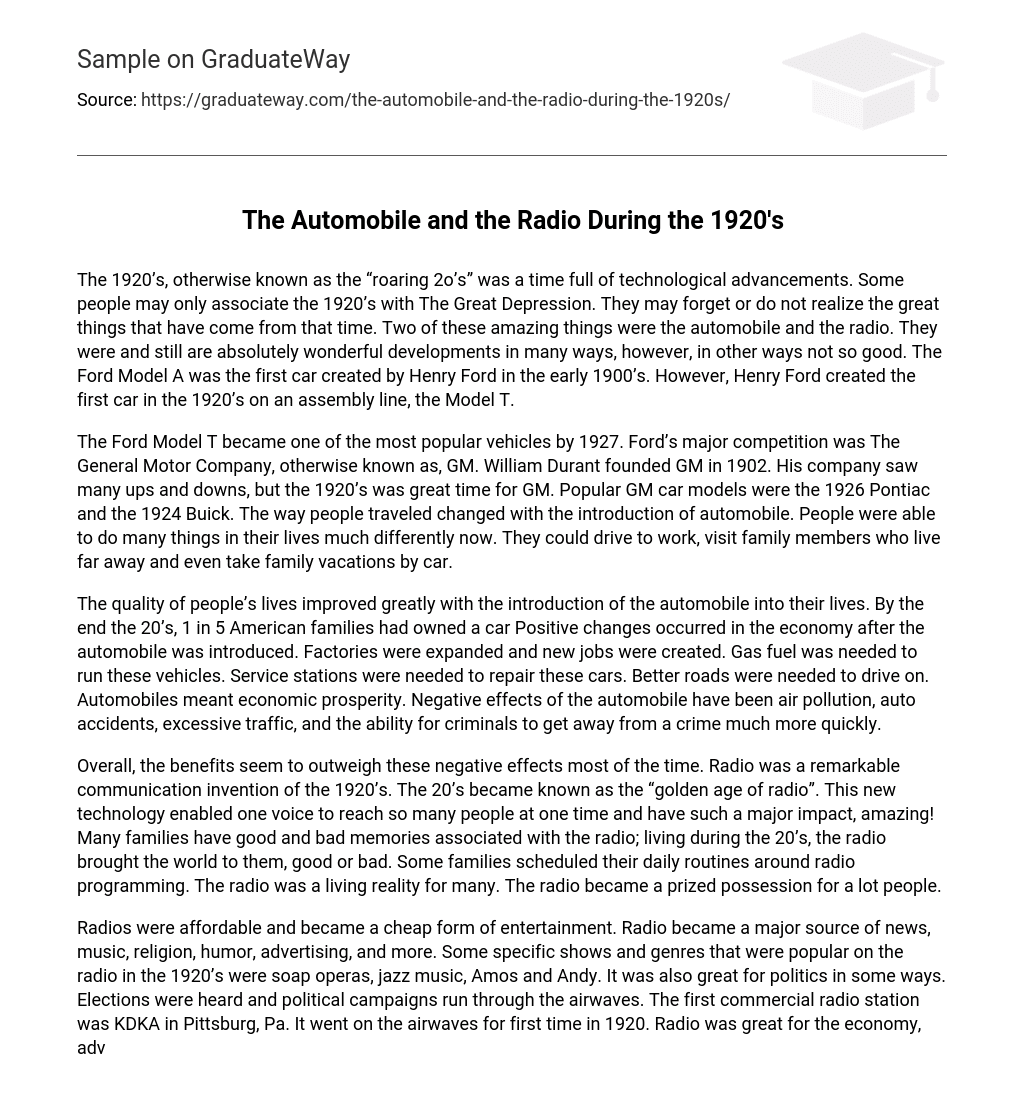The 1920’s, also known as the “roaring 20’s,” witnessed significant technological progress. Despite being commonly associated with The Great Depression, it is important to recognize the impressive accomplishments that arose in this period. Notably, two remarkable innovations were the automobile and the radio, which are still considered extraordinary advancements. However, these developments also had their limitations. Henry Ford first introduced the Ford Model A in the early 1900’s; however, it was not until the 1920’s that he revolutionized production by implementing an assembly line for his creation of the Model T.
In 1927, the Ford Model T faced competition from General Motor Company (GM), which was established in 1902 by William Durant. Nevertheless, GM flourished during the 1920s with their successful car models such as Pontiac and Buick. The introduction of automobiles revolutionized transportation, enabling individuals to conveniently travel to work, visit distant relatives, and embark on enjoyable family vacations.
The introduction of the automobile greatly enhanced people’s quality of life, as evidenced by the fact that by the end of the 1920s, one in five American families owned a car. This led to positive economic changes such as factory expansion and job creation. Moreover, there was an increased demand for gas fuel and service stations. The growing number of cars necessitated better roads, highlighting the association between automobiles and economic prosperity. Nevertheless, automobiles have also brought about negative consequences including air pollution, auto accidents, traffic congestion, and enabling criminals to escape crimes more swiftly.
Despite some negative effects, the benefits of radio generally surpass them. Radio, invented in the 1920s, was a groundbreaking communication tool that revolutionized society and earned the title “golden age of radio”. Its ability to transmit a single voice to a vast audience simultaneously was truly remarkable. Families welcomed this technology into their homes, creating both positive and negative memories. Some families even structured their daily routines around radio shows, showcasing its significance as an integral part of their lives. Consequently, many individuals cherished owning a radio.
During the 1920s, radios became an affordable and inexpensive means of entertainment. They served as a primary source for news, music, religion, humor, and advertisements. Popular genres during this time included soap operas, jazz music, and the show Amos and Andy. Furthermore, radio played a crucial role in broadcasting elections and political campaigns, thus having a significant impact on politics. The first commercial radio station called KDKA in Pittsburg began its broadcast in 1920. Additionally, the economy was greatly influenced by radio through the introduction of commercials which started airing in 1922.
The beginning of mass marketing was marked by the launch of KDKA, the first commercial radio station in Pittsburg, Pa, in 1920. It introduced a technique where a single voice would advertise and endorse different places or products to reach a wide audience. This method proved to be highly effective and continues to be prevalent today. In 1926, the establishment of the National Broadcasting Company (NBC) created the first radio network. Radio served various purposes including providing news updates, weather reports, entertainment, sports coverage, religious content, and advertising. Due to the increasing number of people using airwaves for communication, regulation became necessary.
The national broadcasting company’s role is to issue licenses and assign frequencies and call signs for airwave users. The emergence of automobiles and radios in the 1920s had a lasting effect, and technology is constantly advancing to meet the needs of an ever-changing world. It is hard to envision a society without cars and radios as they greatly shape our culture. The impact of these inventions on individuals is truly remarkable, resulting in widespread consequences.





